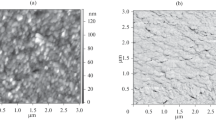Abstract
By X-ray microprobe analysis, X-ray phase analysis, IR spectroscopy, high resolution scanning electron microscopy, and atomic force microscopy thermally stimulated surface heterosegregation is studied in non-oxygen and oxygen-containing single crystals with the participation of oxygen. It is concluded that sodium chlorite NaClO2 and sodium hydrocarbonate NaHCO3 are formed on the surface of sodium chloride NaCl, gallium oxide Ga2O3 on the surface of gallium arsenide GaAs, titanium dioxide TiO2 and lead oxide PbO on the surface of lead titanate PbTiO3, the complex oxide Bi2Ti4O11 and bismuth oxide Bi2O3 on the surface of bismuth titanate Bi4Ti3O12, the complex oxides Bi2Fe4O9, Bi26– xFexO39 and bismuth oxide Bi2O3 on the surface of bismuth ferrite BiFeO3, the complex oxide Pb3GeO5 and lead oxide PbO on the surface of lead germanate Pb5Ge3O11. The mechanisms of the formation of surface oxygen-containing phases including the self-diffusion of matrix crystal atoms to the surface, the migration of segregated atoms on the surface, the evaporation and absorption of molecules of water, carbon oxides, hydrocarbons, oxygen, as well as the surface reactions of segregated atoms with the participation of both lattice oxygen and oxygen of the external environment are reported.



Similar content being viewed by others
REFERENCES
Yu. Ya. Tomashpolsky, V. M. Matyuk, and N. V. Sadovskaya, J. Surf. Invest.: X-Ray, Synchrotron Neutron Tech., 9 (3), 581 (2015).
Yu. Ya. Tomashpolsku, Surface Autosegregation in Chemical Compounds (Nauchnyi mir, Moscow, 2013) [in Russian].
Yu. Ya. Tomashpolsky, N. V. Sadovskaya, and G. A. Grigorieva, J. Surf. Invest.: X-Ray, Synchrotron Neutron Tech., 7 (5), 900 (2013).
Yu. Ya. Tomashpolskii, Russ. J. Gen. Chem. 72 (4), 632 (2002).
Yu. Ya. Tomashpol’skii, I. Ya. Kolotyrkin, and O. V. Petrova, Poverkhnost: Fiz., Khim., Mekh., No. 8, 103 (1985).
E. N. Lubnin, Candidate’s Dissertation in Physics and Mathematics (Moscow, 1983).
Yu. Ya. Tomashpolsky and N. V. Sadovskaya, J. Surf. Invest.: X-Ray, Synchrotron Neutron Tech., 4 (5), 811 (2010).
Yu. F. Kargin, V. I. Burkov, A. A. Mar’in, et al., Bi 12 M x O 20 ± δ Crystals with a Sillenite Structure: Synthesis, Structure, and Properties (Nauka, Moscow, 2004) [in Russian].
Yu. F. Kargin, Doctoral Dissertation in Chemistry (Moscow, 1998).
Yu. Ya. Tomashpolsky, I. Ya. Kolotyrkin, and E. N. Lubnin, J. Microsc. Spectrosc. Electron. 10, 521 (1985).
I. Ya. Kolotyrkin, O. V. Petrova, and Yu. Ya. Tomashpolsky, Neorg. Mater. 21 (11), 1968 (1985).
P. A. Shcheglov, S. A. Men’shikh, S. G. Prutchenko, et al., Neorg. Mater. 6 (1), 77 (2000).
K. Okazaki, Ceramic Engineering for Dielectrics (Gakkensha, Tokyo, 1964; Energiya, Moscow, 1976).
V. V. Prisedskii, V. P. Komarov, G. F. Pan’ko, et al., Dokl. Akad. Nauk SSSR 247 (3), 620 (1979).
Author information
Authors and Affiliations
Corresponding authors
Additional information
Translated by L. Mosina
Rights and permissions
About this article
Cite this article
Tomashpolsky, Y.Y., Matyuk, V.M., Sadovskaya, N.V. et al. Composition, Morphology and Mechanisms of the Formation of Oxygen-Containing Phases in Surface Heterosegregation Processes. J. Surf. Investig. 13, 442–450 (2019). https://doi.org/10.1134/S1027451019030200
Received:
Revised:
Accepted:
Published:
Issue Date:
DOI: https://doi.org/10.1134/S1027451019030200




